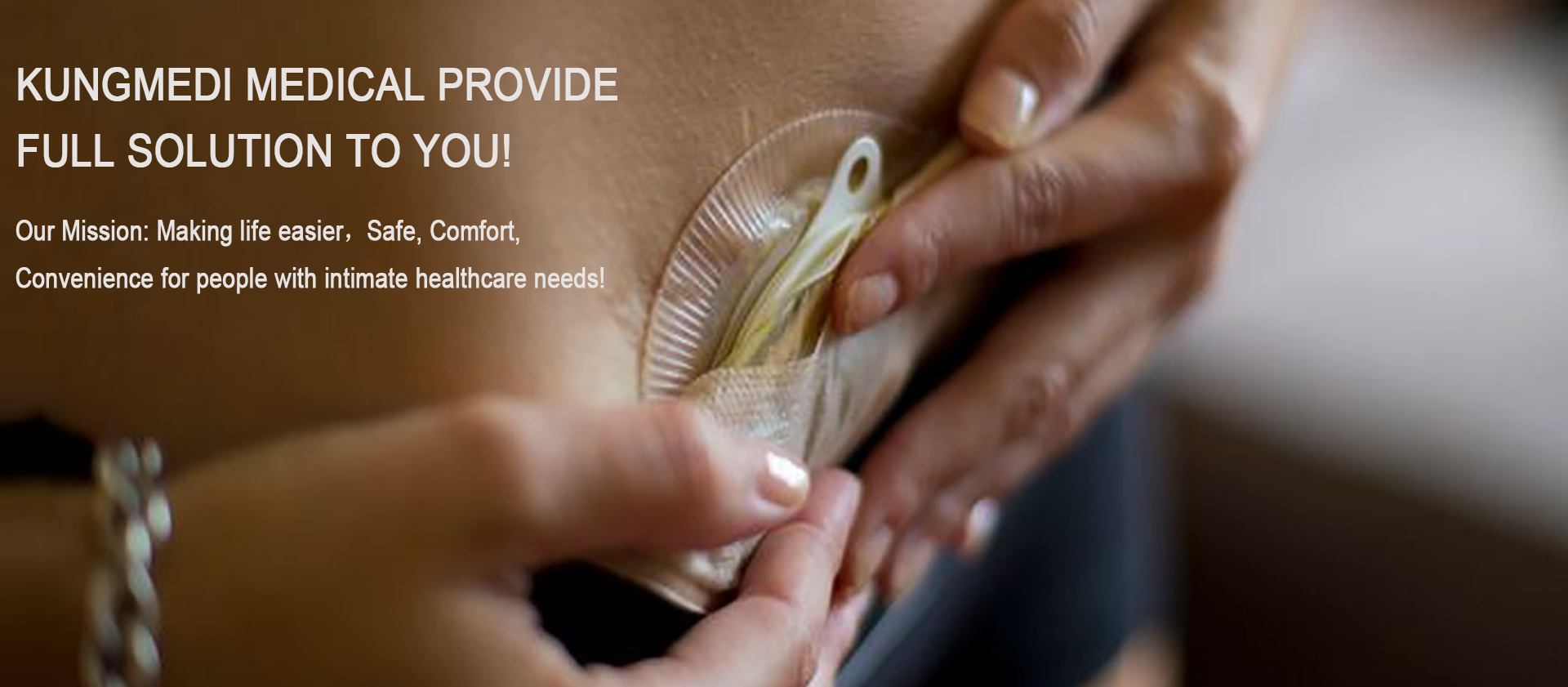Q: How do I know which ostomy pouching system is the best for me?
A: When selecting a pouching system, you want to find the best fit and formulation for your stoma and peristomal skin. KANGDA Secure Start services can help you find a product that will work for you. To learn more about how to choose ostomy products, read the Using Ostomy Products articles in our Ostomy Learning Center.
Q: How do I measure my stoma?
A: Measure your stoma using a stoma measuring guide before every skin barrier application. Stoma measuring guides are available in KANGDA cut-to-fit skin barrier product boxes, and are also available through your ostomy care nurse. It is especially important to measure the stoma regularly during the first six to eight weeks after surgery, until the stoma size stabilizes. After that time, measure periodically. For more information, view our How to Measure Your Stoma video.
Q: How do I cut my skin barriers?
A: First, measure your stoma using a stoma measuring guide. Then, trace the determined barrier size opening onto the skin barrier. Using a small curved scissors, carefully cut an opening in the skin barrier to match the pattern. Do not cut beyond the line on the release liner. The skin barrier should fit where your skin and stoma meet. Verify that no skin is showing between the skin barrier and your stoma to help prevent leakage and skin irritation. For more information, read our care tips on how to apply a one-piece pouching system or a two-piece pouching system. You can also view our “Using Pouching Systems” ostomy educational videos.
Q: DoesKANGDA have pre-sized skin barrier options available?
A: KANGDA has many pre-sized skin barrier options. Pre-sized skin barriers are intended for round stomas that have maintained a consistent size. Stoma size will change during the first six to eight weeks after surgery and may change with any weight gain or loss. Measure your stoma frequently to ensure it is maintaining a consistent size.
Q: What are convex skin barriers, and doesKANGDA offer them?
A: Convex skin barriers promote a good fit between the ostomy pouching system and the peristomal skin in cases where flat barriers may have been unsuccessful. Convex barriers curve outward and push down on the skin immediately surrounding the stoma (i.e., the peristomal skin) to open or flatten skin folds or help direct the drainage away from the barrier.
KANGDA offers several skin barriers with soft or firm integrated convexity. Adapt Convex Barrier Rings can also be added to pouching systems to create soft convexity with a flat barrier, or create deeper convexity with a convex (soft or firm) barrier.
Contact an ostomy care nurse if you experience stoma/peristomal changes, pouching system leakage, or weight gain/loss that may have impacted your skin barrier seal. For more information on convexity, read our Using Convexity and Convex Barrier Options care tips sheets. You can also view our “How to Use Adapt Convex Barrier Rings” ostomy educational video.
Q: How do I prepare my skin before putting on a new ostomy pouching system?
A: Less is better when caring for the skin around your stoma. For most people, water is sufficient for cleaning the skin. If soap is needed, use a mild bar soap without lotions or creams that may leave a residue or film on your skin and possibly interfere with the adhesive. Skin protective wipes or sprays are not recommended under extended wear skin barriers as this may decrease your wear time (i.e., how long you can wear your skin barrier before it fails). Make sure the peristomal skin is clean and dry before applying your skin barrier.
If you develop red, itching, irritated, or broken peristomal skin, seek the assistance of a healthcare professional. For more information on skin care, read our Peristomal Skin Care Tips and the Maintaining Healthy Skin articles in our Ostomy Learning Center.
Q: How do I apply my ostomy pouching system?
A: For step-by-step instructions, read our care tips on how to apply a one-piece pouching system or a two-piece pouching system, or view our “Using Pouching Systems” ostomy educational videos.
Q: What features doKANGDA ostomy pouches have?
A: KANGDA ostomy pouches come in different lengths and with many different features to suit your needs. Some of the most common features are:
· Closure systems – KANGDA offers closed ostomy pouches which cannot be drained, and we also offer drainable ostomy pouches, which have either a clamp that can be removed when emptying the pouch or the Lock ‘n Roll microseal closure that is built into the pouch. Our urostomy pouches (i.e., pouches that hold urine) have a drainage tap.
· Filters – Many of our ostomy pouches include our integrated AF300 filter, which does not require a sticker and helps minimize gas buildup, so the pouch does not inflate like a balloon. The filter slowly lets the gas out, but not the odor.
· Visibility – For visibility, you can choose from transparent and opaque pouch options. You can select pouches that have an opaque soft covering on the front to help increase your comfort and provide added discretion, or select pouches with a transparent front for visibility. All of our pouches have a soft panel on the body side. In addition, we offer a viewing option on our Premier one-piece pouching system which provides the discretion of an opaque panel and the visibility of a clear pouch all-in-one.
Q: How does an ostomy pouch filter work?
A: Some pouches include filters that help minimize gas from buildup, so the pouch does not inflate like a balloon. A pouch filter is designed to deflate the pouch when there is gas and to neutralize the gas odor. The keys to filter performance are airflow, deodorization, and liquid protection. For more information, read Tips for Minimizing Ostomy Odors and Gas in our Ostomy Learning Center.
Q: Will water ruin an ostomy pouch filter?
A: Our AF300 filter, available on many of our ostomy pouches, is designed to resist water and does not need to be covered.
Q: How do I use the Lock ‘n Roll microseal closure?
A: The Lock ‘n Roll microseal closure is a feature on many KANGDA drainable ostomy pouches. For more information and step-by-step usage instructions, read our Lock ‘n Roll Microseal Closure Care Tips.
Q: How do I use the drain tap onKANGDA urostomy pouches?
A: The tap is a twist valve that you can turn to open and close it. In order to make urine flow, the teardrop must be facing away from your body. To make sure the drain valve is closed, the teardrop must be facing towards your body. For more information, view our “How to Empty a Urostomy Pouch” ostomy educational video.
Q: How often should I empty my ostomy pouch?
A: Pouch volume varies by pouch type but we suggest emptying your pouch when it is 1/3 to 1/2 full of output or gas. Do not let the pouch overfill, and be sure to empty it before activities and before bedtime. For more information, view our “Using Pouching Systems” ostomy educational videos.
Q: How often should I change my ostomy pouching system?
A: Change your skin barrier on a routine basis. You will get more comfortable with this after you learn what works best for you. Wear time (i.e., how long you can wear your skin barrier before it fails) is based on skin barrier fit and formulation, personal preference, and stoma characteristics. We do not recommend a wear time longer than five to seven days. For additional guidance, read Your Ostomy Pouching System and Wear Time in our Ostomy Learning Center. You can also view our “Using Pouching Systems” ostomy educational videos.
Q: Can I put water or oils in my ostomy pouch to make emptying easier?
A: Rinsing out your pouch with water is not necessary or recommended. Getting water around the stoma may cause the adhesive skin barrier to break down, which can lead to leakage. A lubricating deodorant made specifically for ostomy pouching systems, such as Adapt Lubricating Deodorant, can help make pouch emptying easier and is most suitable for those with colostomies or ileostomies. Do not put oils, cooking sprays, or other products not intended for use with an ostomy in your pouch.
Q: What is the best ostomy pouch to use when prepping for a colonoscopy?
A: We recommend using a 12” (30 cm) drainable ostomy pouch when prepping for a colonoscopy procedure. During your preparation, you should expect to drain your pouch more frequently than normal. Regardless of the drainable pouch you choose, it is important to empty the pouch when it is 1/3 to 1/2 full.
Q: What pouching system should I use for my high output ostomy?
A: KANGDA offers a high output pouch with a soft tap drain that fits comfortably against the skin and eases pouch emptying. This pouch comes in one-piece and two-piece options, and may be connected to a bedside drainage collector with no need for an adapter. These pouches are most suitable for colostomies or ileostomies with liquid output.
Q: What products do I use for a fistula?
A: A fistula is an abnormal opening between two hollow organs, or between a hollow organ and the skin. If the fistula output is minimal, gauze dressings may be sufficient for containment. However, if the fistula output volume is significant or frequently soaks through the dressing, a pouch may be more appropriate. Most pouching options can be used to manage a fistula, but this use may not be covered by your insurance. Please contact your insurance provider to discuss product coverage. For more information, read our Fistula Management Care Tips.
Q: Why did my ostomy pouching system suddenly stop working well?
A: There are several reasons why you may suddenly need to change your pouch more frequently. Seek the advice of your ostomy care nurse or contact the KANGDA Secure Start services team.
Q: Is my KANGDA ostomy pouching system safe for an MRI?
A: All of the KANGDA one- and two-piece ostomy pouches and skin barriers (with the exception of the soft wire closure found on our preemie and newborn pediatric pouches and our colostomy irrigation sleeves) are non-magnetic and non-metallic, which is considered to be MRI-safe. Any of our accessory products that come in a pump-spray, such as M9 Odor Eliminator Spray, should not enter the MRI room due to the metal spring in the pump. Generally, if a product does not contain metal, it is safe for use in an MRI. However, we have not tested each of our products individually to assess compatibility for use in a Magnetic Resonance Environment.














